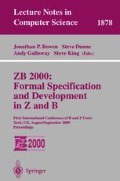Abstract
Simply-typed set-theoretic languages such as Z and B are widely used for program and system specifications. The main technique for reasoning about such specifications is induction. However, while partiality is an important concept in these languages, many standard approaches to automating induction proofs rely on the totality of all occurring functions. Reinterpreting the second author’s recently proposed induction technique for partial functional programs, we introduce in this paper the new principle of “closure induction” for reasoning about the inductive properties of partial functions in simply-typed set-theoretic languages. In particular, closure induction allows us to prove partial correctness, that is, to prove those instances of conjectures for which designated partial functions are explicitly defined.
D. Duffy was supported by the EPSRC under grant no. GR/L31104.
J. Giesl was supported by the DFG under grant no. GI 274/4-1.
Access this chapter
Tax calculation will be finalised at checkout
Purchases are for personal use only
Preview
Unable to display preview. Download preview PDF.
References
R. D. Arthan. Undefinedness in Z: Issues for specification and proof. In CADE-13 Workshop on Mechanisation of Partial Functions. New Brunswick, New Jersey, USA, 1996.
F. Baader and T. Nipkow. Term rewriting and all that.Cambridge University Press, 1998.
G. Birkhoff. On the structure of abstract algebras. Proc. Cambridge Philos. Soc. 31:433–454, 1934.
A. Bouhoula and M. Rusinowitch. Implicit induction in conditional theories. Journal of Automated Reasoning, 14:189–235, 1995.
R. S. Boyer and J S. Moore. A Computational Logic. Academic Press, 1979.
J. Brauburger and J. Giesl. Termination analysis by inductive evaluation. In Proc. CADE-15, LNAI 1421, pages 254–269. Springer, 1998.
J. Brauburger and J. Giesl. Approximating the domains of functional and imperative programs. Science of Computer Programming, 35:113–136, 1999.
F. Bronsard, U. S. Reddy, and R. W. Hasker. Induction using term orders. Journal of Automated Reasoning, 16:3–37, 1996.
A. Bundy, A. Stevens, F. van Harmelen, A. Ireland, and A. Smaill. Rippling: A heuristic for guiding inductive proofs. Artificial Intelligence, 62:185–253, 1993.
N. Dershowitz and J.-P. Jouannaud. Rewrite systems. In Handbook of Theoretical Computer Science, volume B, pages 243–320. North-Holland, 1990.
D. A. Duffy. On partial-function application in Z. In 3rd Northern Formal Methods Workshop, Ilkley, UK, 1998. Springer. http://www.ewic.org.uk/ewic/.
J. Giesl. The critical pair lemma: A case study for induction proofs with partial functions. Technical Report IBN 98/49, TU Darmstadt, 1998. http://www. inferenzsysteme.informatik.tu-darmstadt.de/~reports/notes/ibn-98-49.ps.
J. Giesl. Induction proofs with partial functions. Journal of Automated Reasoning, 2000. To appear. Preliminary version appeared as Technical Report IBN 98/48, TU Darmstadt, Germany. Available from http://www.inferenzsysteme.informatik.tudarmstadt.de/~giesl/ibn-98-48.ps.
J. Giesl, C. Walther, and J. Brauburger. Termination analysis for functional programs. In W. Bibel and P. Schmitt, editors, Automated Deduction-A Basis for Applications, Vol. III, Applied Logic Series 10, pages 135–164. Kluwer, 1998.
J. A. Goguen, J. W. Thatcher, and E. G. Wagner. An initial algebra approach to the specification, correctness, and implementation of abstract data types. In R. T. Yeh, editor, Current Trends in Programming Methodology, volume 4. Prentice-Hall, 1978.
B. Gramlich. Abstract relations between restricted termination and confluence properties of rewrite systems. Fundamenta Informaticae, 34:3–23, 1995.
C. B. Jones. Partial functions and logics: A warning. Information Processing Letters, 54:65–67, 1995.
D. Kapur. Constructors can be partial, too. In R. Veroff, editor, Automated Reasoning and its Applications-Essays in Honor of Larry Wos, pages 177–210. MIT Press, 1997.
D. Kapur and M. Subramaniam. New uses of linear arithmetic in automated theorem proving by induction. Journal of Automated Reasoning, 16:39–78, 1996.
J. M. Spivey. The Z Notation: A Reference Manual, Second Edition. Prentice Hall, 1992.
I. Toyn. Z standard(draft). Available from the Department of Computer Science, University of York at http://www.cs.york.ac.uk/~ian/zstan, 1999.
I. Toyn. CADiZ. Available from the Department of Computer Science, University of York at the web address http://www.cs.york.ac.uk/~ian/cadiz/home.html, 2000.
I. Toyn, S. H. Valentine, and D. A. Duffy. On mutually recursive free types in Z. In Proceedings International Conference of Z and B Users, ZB2000, LNCS. Springer, 2000. To appear.
S. Valentine. Inconsistency and undefinedness in Z-a practical guide. In Proceedings 11th International Conference of Z Users, ZUM’98, LNCS 1493, pages 233–249. Springer, 1998.
C. Walther. Mathematical induction. In D. M. Gabbay, C. J. Hogger, and J. A. Robinson, editors, Handbook of Logic in Artificial Intelligence and Logic Programming, volume 2. Oxford University Press, 1994.
C.-P. Wirth and B. Gramlich. On notions of inductive validity for first-order equational clauses. In Proc. CADE-12, LNAI 814. Springer, 1994.
H. Zhang, D. Kapur, and M. S. Krishnamoorthy. A mechanizable principle of induction for equational specifications. In Proc. CADE-9, LNAI 310, pages 162–181. Springer, 1988.
Author information
Authors and Affiliations
Rights and permissions
Copyright information
© 2000 Springer-Verlag Berlin Heidelberg
About this paper
Cite this paper
Duffy, D.A., Giesl, J. (2000). Closure Induction in a Z-Like Language. In: ZB 2000: Formal Specification and Development in Z and B. ZB 2000. Lecture Notes in Computer Science, vol 1878. Springer, Berlin, Heidelberg. https://doi.org/10.1007/3-540-44525-0_28
Download citation
DOI: https://doi.org/10.1007/3-540-44525-0_28
Published:
Publisher Name: Springer, Berlin, Heidelberg
Print ISBN: 978-3-540-67944-8
Online ISBN: 978-3-540-44525-8
eBook Packages: Springer Book Archive

